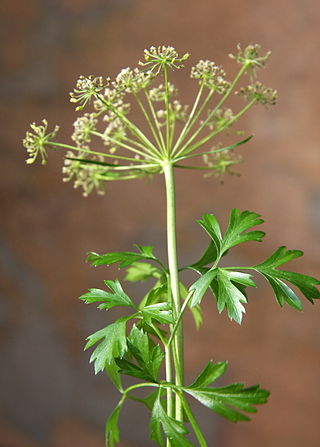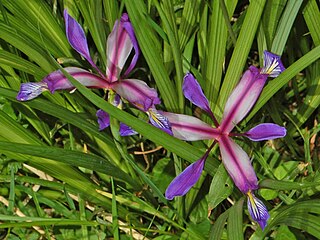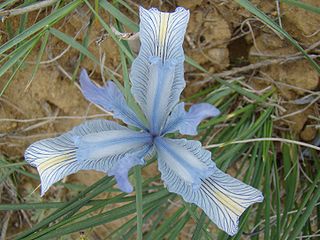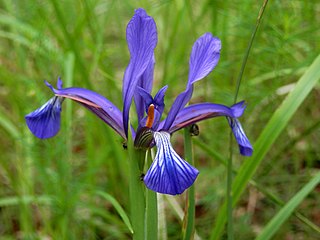
Parsley, or garden parsley is a species of flowering plant in the family Apiaceae that is native to Greece, Morocco and the former Yugoslavia. It has been introduced and naturalized in Europe and elsewhere in the world with suitable climates, and is widely cultivated as a herb, and a vegetable.

Iris douglasiana, the Douglas iris, is a common wildflower of the coastal regions of Northern and Central California and southern Oregon in the United States. It grows mainly at lower elevations, below 100 meters (330 ft), though it is occasionally found at heights of up to 1,000 meters (3,300 ft). It is most common in grasslands near the coast.

Chamaenerion angustifolium is a perennial herbaceous flowering plant in the willowherb family Onagraceae. It is known in North America as fireweed, in some parts of Canada as great willowherb, in Britain and Ireland as rosebay willowherb. In the United Kingdom it is also known as bombweed, as a result of its rapid appearance on city bomb sites during the Blitz of World War II; the plant is also traditionally known as Saint Anthony's laurel. It is also known by the synonyms Chamerion angustifolium and Epilobium angustifolium. It is native throughout the temperate Northern Hemisphere, including large parts of the boreal forests.

Iris ser. Longipetalae is a series of the genus Iris, in Iris subg. Limniris.

Mitella diphylla is a clump forming, open woodland plant native to northeast and midwest regions of North America.

Iris cristata is a species in the genus Iris, it is also in the subgenus of Limniris. It is a rhizomatous perennial plant, endemic to the eastern United States. It has pale lavender flowers with a white patch and orange or yellow crest. It is a close relative to Iris lacustris, the only other crested iris native to North America. It is cultivated as an ornamental plant in temperate regions.

Artemisia douglasiana, known as California mugwort, Douglas's sagewort, or dream plant, is a western North American species of aromatic herb in the sunflower family.

Iris fernaldii, commonly known as Fernald's iris, is a species of iris endemic to western Northern California. It is native to the Inner and Outer North California Coast Ranges, such as the Santa Cruz Mountains, and surrounding the San Francisco Bay Area. It is found between 164–6,562 feet (50–2,000 m) in elevation. It grows in full sun near the coast, and afternoon shade inland.

Iris purdyi is a species of iris known by the common name Purdy's iris, named after Carl Purdy. It is found in the redwood forests of California and into southern Oregon, and hence is also known as the redwood iris. The plant flowers from April to June.

Iris milesii is a plant species in the genus Iris, subgenus Limniris and in the section Lophiris. It is a rhizomatous, beardless perennial plant, native to the Himalayas, India and China. It has pinkish-violet, or pinkish purple, or pinkish-lavender or pinkish lilac flowers, with a fringed yellow or orange crest. It is cultivated as an ornamental plant in temperate regions.

Iris graminea is a species of flowering plant belonging to the subgenus Limniris of the genus Iris, in particular the series Spuriae. It is a rhizomatous perennial, with purple or violet blue flowers almost hidden by narrow, grass-like leaves, and a plum scented fragrance. It is cultivated as an ornamental plant in temperate regions. It has several common names, including grass-leaved flag, grass leaved iris, plum iris and plum tart iris. This species naturally occurs in the southern half of Europe, from Spain and France in the West to Russia and the Caucasus in the East.
Iris tenuis is a plant species in the genus Iris, subgenus Limniris. It is a rhizomatous perennial, endemic to Clackamas County, Oregon. The flowers are white, pale blue or lilac, with a yellow or golden low dissected crest and pale green leaves. It is cultivated as an ornamental plant in temperate regions.

Iris variegata, commonly known as the Hungarian iris, is a plant species in the genus Iris, also in the subgenus Iris. It is a rhizomatous perennial from eastern Europe. It has dark green, ribbed leaves. The branched flowering stems can be as tall as the leaves, they can hold 2–3 flowers in summer. They are yellowish-white, with brown-purple veins on the drooping falls. It is very hardy and it is commonly cultivated as an ornamental plant in temperate regions. There are several cultivars.

Iris series Spuriae are a series of the genus Iris, in Iris subg. Limniris. They are sometimes commonly known as butterfly irises.

Iris ser. Tripetalae is a series of the genus Iris, in Iris subg. Limniris.
Iris forrestii is a species of flowering plant in the genus Iris, also the subgenus Limniris and in the series Sibiricae. It is a rhizomatous herbaceous perennial, from China and Burma. It has linear grassy-like leaves, long thin stem and fragrant yellow or lemon-yellow flowers. It is cultivated as an ornamental plant in temperate regions.

Iris tenuifolia is a beardless iris in the genus Iris, in the subgenus Limniris and in the series Tenuifoliae of the genus. It is a rhizomatous herbaceous perennial, from a wide region over central Asia, including Afghanistan, Pakistan, ; Kazakhstan, Uzbekistan and Mongolia and in China. It has long greyish-green leaves, short stem and pale violet, lilac, pale blue, or purple flowers.

Iris sintenisii is a species in the genus Iris, it is also in the subgenus Limniris and in series Spuriae, with tall thin stems, violet-blue flowers and long grass-like leaves. It is a rhizomatous perennial plant, from grass meadows parts of Europe, Russia, and Turkey. It is cultivated as an ornamental plant in temperate regions.

Iris korolkowii is a plant species in the genus Iris, it is also in the subgenus Iris and in the section Regelia. It is a rhizomatous perennial, from the mountains of Tien Shan, Pamir and Altai, in Afghanistan and Turkestan. It is commonly known as the Redvein Iris. It has long, sword-shaped grey-green leaves, slender stem, and 2 to 3 white, cream, pale green or light purple flowers which are veined with maroon, chocolate brown or dark purple. It is cultivated as an ornamental plant in temperate regions.

The identity of the plant first described by Carl Linnaeus as Iris florentina remains unclear, as of December 2021. In horticulture, it has been treated as a white-flowered variant of Iris × germanica, under names such as Iris germanica nothovar. florentina, Iris × germanica var. florentina and Iris × germanica 'Florentina'. Iris florentina has also been treated as the correct name for the true species also known as Iris albicansLange.


















